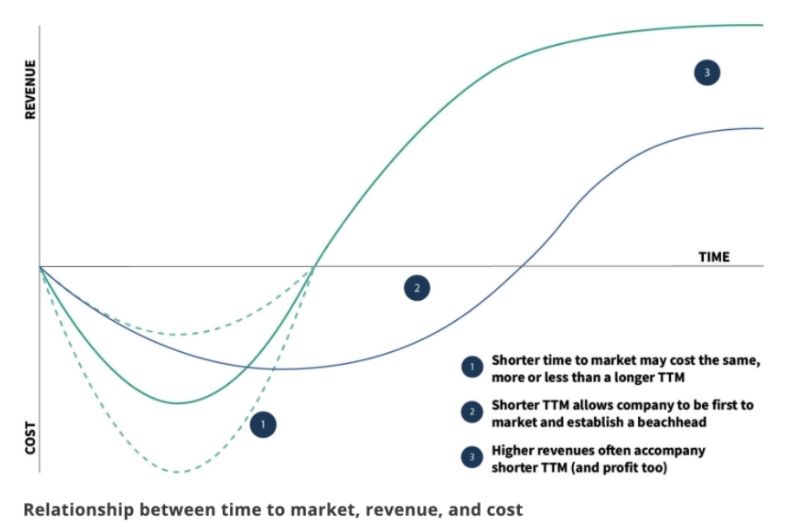Time to Market
Time to Market (TTM) is the time it takes from a product’s development until its launch in the market. TTM is one of the most essential product development performance indicators for startups as it highlights the main steps in the Research and Development phase. Time to market includes all the key elements required when developing a new product:
- Generating a product’s idea;
- Design;
- Development;
- Market launch.
In a nutshell, TTM depends on the product’s complexity and the readiness to launch an MVP (minimum viable product). Time to market is proportional to the complexity of a product. However, a complex product can be launched in parts. Following that scenario, the first step is to launch the MVP.
MVP
An MVP is a minimum viable product with a set of basic functions. That being said, it is obvious that these functions should reflect the core purpose of the product.
This way, it’s advisable to include the highest priority’s central functions and leave non-vital features to the final release. And here comes the doubt. It’s not unusual when I hear something like that: “Sure, I know what an MVP is. But you know what: this particular feature defines the whole solution. Can we leave it? ”
The answer is a straightforward “no.” If you really want to shorten time to Market, be pragmatic. In 99 cases out of 100, you work against time, so be sure not to include any secondary features even if you personally like them. Definitions Of Done will help you to make a list of the required elements.
This way, the whole question boils down to determining the MVP’s functionality. When thinking about its creation, the universal rule is to do it as efficiently as possible. Surely, quality matters a lot, and it should always be prioritized over speed. Well, unless you have time, patience, and resources to redo everything.
Why reducing time to market
First of all, let’s see why in some cases time to market might take longer than expected. Basically, there are two reasons behind the slowdown: the inability to make quick decisions and excessive analysis for the sake of analysis.
In a better world, TTM should be shortened at any reasonable cost. According to the research by Strategy+Business, pioneers in the market have tangible advantages in terms of revenue, market share, and further growth. Let’s see the graph:

As follows from the chart above, MVP significantly reduces time to market.
TTM is especially vital in times of pandemic. As a rule, businesses do not have extra resources to invest in projects during difficult times without a quick return. Besides, how can one be confident that the project will take off? Generally, startup founders ask themselves a lot of questions. What exact features are people interested in? Will we be able to translate them into actual sales numbers? Do we have the right technology?
What’s more, reducing time to market allows companies to make significant savings. By shortening the time to market from a few months to a few weeks, these resources can be diverted to other uses.
In the aftermath of the financial crisis of 2008, the notion of TTM came into the spotlight. In 2008, only 58% of service providers considered it the most important business indicator. However, three years later, the figure increased to 70%. Nowadays, this metric is one of the most discussed topics in companies that bring new products to markets.
Partnerships
The other way of hitting the market earlier is in partnerships. If you don’t have enough expertise in software development, it’s a good idea to find someone who does. I mean, with a reliable technological partner by your side, it’s easier to concentrate on your product vision and purely business aspects. The cooperation with a team of professionals translates into innovation and speed, and daily meetings make sure you’re on the right track.
In most cases, managing a startup is more about the way of execution than the idea itself. Therefore, experienced software developers can make a difference straight away.
Key takeaway
Time to Market is a critical economic metric of a startup, and the best way to shorten time to market is to start with an MVP. The report by McKinsey & Co claims that a product that appears in the market six months late gets 33% less profit over the period of five years.
However, I can’t stress it enough: don’t sacrifice quality for the sake of speed. Instead, accelerate the development process by optimizing the workflow, reducing tasks in the process, competently prioritizing and decomposing tasks. Work following the Agile methodology – be self-organized, avoid unnecessary documentation and lengthy approvals.
Agile’s principles are universal to any type of company, not just startups, of course. Put an emphasis on client feedback and be flexible. Thus, focus on the rapid launch. If an MVP provides enough value, customers will use it no matter the limited functionality. And that’s exactly the point.











